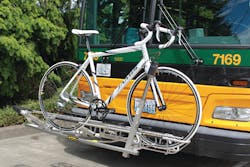In the metropolitan Toronto region of Ontario, planners and transit agencies have a good problem on their hands.
In the region covered by Metrolinx, ridership has seen a 5 to 7 percent increase annually and $16 billion is being spent on new capital projects, such as a new 26-kilometer light rail line across Toronto. But with increasing service and increasing demand for transit comes a new issue Metrolinx and other agencies must overcome — connecting transit riders to transit.
“One of our big challenges that had to be included with the GO Train project is having really thoughtful planning to really integrate it seamlessly,” said Daniel Haufschild, director of policy and planning for Metrolinx. “That’s both with the commuter rail side and working to link access to stations.”
Transit agencies and regional planners are looking for more ways accommodate transit riders who don’t live near stops or stations through a variety of first and last mile planning efforts.
Since 2009, Metrolinx has installed more than 40 bike lockers at eight GO stations as part of a pilot program with the city of Toronto and Metrolinx/GO Transit; provided secure bike facilities at GO stations in Hamilton and Burlington; added bike racks to the front of all GO buses; provided a dedicated train coach for bikes on the Niagara Falls summer GO Train service, known as the Toronto-Niagara Greenbelt Express; equipped local transit agency buses with an external bike rack, and installed permanent, secure and sheltered bicycle parking facilities at strategic locations by way of our BikeLinx program and $5 million in funding; and worked to link municipal bike lanes to stations.
But more efforts are still needed to connect transit users with transit.
Pedal Power
“We’ve worked with our regional municipalities on making special bike paths to stations and we just recently finished a major pedestrian bridge running over one of our major — what you call in the states an interstate, but we just call the 401 — to connect to the station,” Haufschild said. “It’s both improving the stations and tying them together with the downtowns and parking.”
Using personal bicycles to access transit is becoming more popular as transit agencies have placed bicycle racks on the fronts of buses so cyclists can take their bike with them when they use the bus. However, the racks have become so popular that some agencies are having capacity issues with the racks.
Derek Sanden, vice president of sales and marketing of Sportworks, said that company has been grappling with the issue for quite some time because potential bus riders with bikes are waiting longer at stops because the racks are full when a bus arrives. He said new racks can support up to three bikes in the front of the bus, but it has been a challenge to come up with a rack that can fit more bicycle while addressing safety issues. In order to add additional capacity, Sanden said wall mounted racks are now being installed in buses in an effort to stow more bicycles.
“I can tell you pretty candidly that three bikes is the most you’re going to see on the fronts of vehicles,” he said. “There’s no other way to put more bikes in front of a vehicle because safety and things like that.”
Sanden said research shows bike locker demand is declining while agencies, city planners, businesses and colleges are turning to ascetically pleasing bike racks that can be placed either inside or outside of buildings and fit anywhere from two to 12 bicycles at a time.
“All the designs we come up with are designed to meet [Association of Pedestrian and Bicycle Professional] rules, they kind of set the golden rule for what makes a good and safe rack,” he said. “We’re not just creating these things in a vacuum. We’re following the golden rules set by this group.”
Richard Hartger, president and CEO of CycleSafe, said bicycle lockers have been a popular option for transit agencies looking to supply ample parking for bike riders to transit because of their security, size and the fact they don’t require larger facilities where multiple bikes are put in place.
Traditionally the lockers would be operated by keys, but Hartger said some agencies are now looking to ways to automate the lockers and allow users to give payment information via the web to improve access and make it easier for people to use.
“Bike racks cost $100 to park a bike while a quality bike locker can cost 10 times that each, but to park a car you’re talking $40,000 to $50,000 to $60,000 per space,” Hartger said. “The majority of parking garages are all paid for with government bonds so when you look at the cost of bicycle parking it’s really a good deal for a community compared to what they pay for parking a car.”
Set it and forget it
Jeff Olson, R.A., principal at Alta Planning & Design, and Alta Bicycle Share, said cities are starting to realize how important first and last mile trips are in connecting people with transit and the community, so planners are increasingly looking for ways to increase the connectivity.
Alta is the operator of the recently launch of Citi Bike in New York City, which has become the largest bike sharing program in the country, which Olson said could have a major impact in how residents and tourists get around there. However, first and last mile trips are becoming increasingly important in suburban and rural areas as well.
“One example of what happens all too often is when kids go to school in suburban or rural communities and then they’re driven to the end of the driveway or the road and then sitting there in an idling car,” Olson said. “But really if you think about it, that’s a first and last mile trip.”
The implementation of a bike share program in the Washington, D.C. area has made transit a more attractive option for residents.
According to a recent survey of members of Capital Bike Share, more than half of surveyed bike share members used a bicycle to access Metrorail, while 23 percent used it to access a bus stop and 9 percent used it to access commuter rail. Lori Duggins, Principal with LDA Consulting said one respondent noted the ability to use a bike as a one-way access to transit made a 10 minute walk into a 90 second ride to transit.
“It made transit more attractive because it removed one of the disadvantages of transit,” she said.
Capital Bike Share is having a significant impact on traffic and congestion in that region.
According to the results of a recent survey of the bike share, 26 percent of those surveyed reduced their car traveled miles by an average of 198 miles. With the reduction, it meant a reduction of 4.4 million miles by bike share members.
However, while bike sharing is making it easier for some to access transit where it’s not readily available, survey results showed there was a measurable impact on the amount of bike users who had reduced their transit usage.
About 21 percent of bike share respondents said they had “much less” use of Metrorail, 19 percent said they had much less use of the bus, while 30 percent reduced the amount of time they drove and 31 percent reduced taxi usage.
Five percent said they sold their car and another 7 percent said they were considering getting rid of their car, with 75 percent of those who at least considering getting rid of their car said it was due to the bike share.
The use of bike share did make it more comfortable for members to use transit, Diggins said, as respondents said they enjoyed having a one-way access to a transit station without having to worry about leaving their property behind.
“It does give us additional opportunities for transit agencies,” she said.
Olson said connecting people to transit with first and last mile modes of transportation extends well beyond infrastructure needs of a city because educational programs need to be put in place to change lifestyles.
“I think the real game changer has been bike sharing,” Olson said. “We just launched in New York City and we’ve had bike sharing in Boston and Washington, D.C., and the success has just been incredible, with Washington having more than 4 million trips alone since it started. It’s really an exciting thing in transportation because it compliments transit in a lot of ways because it not only provides first and last mile trips, and it provides access to service in areas underserved by transit, so we’re seeing one of the great success stories right now.”
Olson also said the cost of the infrastructure to build greenways or bike trails have proven to be much more affordable options to help commuters than traditional road expansions.
“This is my third decade involved with these issues and when I first started, the questions I got all the time was why should we do this, why is it even important,” Olson said. “In the last two decades with public safety concerns and health concerns and job creation issues, we’re at a point now where all those issues have come together and now the question we most often get now is how quickly can we get it done.”
With the success of Capital Bike Share, Sandra Brecher, chief of commuter services for the division of transit services in the department of transportation for Montgomery County, Maryland, said that county is launching its own bike share program to get riders to and from Washington Metropolitan Transit Authority stations within the county, which will be seamlessly integrated into Capital Bike Share in what will be a first for a suburban community in the U.S.
“We think it’s really going to help people in terms of access of a Metro rider to a Metro station or to a bus and give them a place to dock the bike and not having to worry about the bike being there all day,” she said.
Car sharing proves a powerful ally
As CEO of a car sharing program, Sharon Feigon is trying to change the habits of a country that have been established over the past six decades.
Feigon is CEO of IGO car sharing, a non-profit entity in Chicago — which was recently purchased by Enterprise — that tested out people to see if they would be willing to share cars in an effort to reduce car ownership and create a beneficial economic and environmental impact by encouraging them to walk, ride a bicycle and use transit. So when IGO got a chance to partner with the Chicago Transit Authority, she said it was an opportunity that needed to be seized.
“Working with CTA seemed like a natural fit,” she said. “It really seemed like the natural thing to do.”
In 2009 IGO began a partnership with CTA which coupled fare media so those who obtained a Chicago Plus CTA card could use the card to access an IGO vehicle. An RFID chip was placed onto the fare cards so it could work in tandem with IGO.
Feigon said CTA has provided parking spaces for IGO cars and the addition of the common fare media between the two entities made it easier for IGO members to use CTA trains and buses. The media was paid for by grants and Feigon said the same cards work with Pace Suburban Bus as well.
“At the time we approached CTA we were really fortunate because they were open to it,” she said. “We moved pretty quickly to combine the cars, but it was difficult at first because of the proprietary nature of the software.”
Fegion said IGO is currently working on a project to help assist reverse commuters to the suburbs by giving them access to cars at Metra stations that are actually owned by other IGO members who commute into the city. Commuters who allow their personal vehicle to be used as a shared car as part of IGO would be paid a fee and instead of the car sitting in a Metra parking lot all day, it would be used by someone commuting to the suburbs from the city, who could then use the car to get to their jobs.
“It’s especially important for transit to be working right now to connect people walking and biking in order to overcome a county that’s increasingly car dependent and fossil fuel dependent, Olson said. “If we’re going to get to a point to really change this and to give people that choice of walking or biking to transit, we’re going to need a truly integrated transportation system. We need to figure out the right solutions to fit people’s needs.”
Brecher said one of the key ways to encourage people to use transit is to make it easier to connect people to stations and stops, so several years ago the county began a car sharing program where the county worked with car sharing companies to make spaces available for them. The program has boomed in popularity so parking spaces are now made available to car sharing companies in mostly urban areas of the county.
“This actually enables somebody to use an alternate mode to get to and from work but still have an option at their employment centers to use a car when they need one,” she said.
One effort Metrolinx has started is a carpool program running from commuter rail stations. Since the effort was stated about a year ago, it has proven to be wildly popular with 750 people registered to take part in the program, with that number expected to eclipse 1,000 soon. The agency is also in the midst of working on a car share program to accommodate riders.
Fegion said IGO is currently working with the Chicago area transit agencies as they move over to the new Ventra payment system, however, that agreement is still being worked out.
“Our vision is of one card that would be integrated with the new bike sharing and we’d like it to be integrated with CTA, Pace and Metra, and anything else that comes along,” she said. “But right now we’re still working on integrating with CTA.”
But the issue of shared media shouldn’t end in Chicago, said Feigon, who said a national approach to the integration of media between transit agencies, bike shares and car shares should be established in order to make it easier for users to access transportation anywhere.
“Having it all work together just makes more sense, but what I’d really like to see is a joint smart card that shouldn’t be just Chicago,” Feigon said. “Why not be able to use it in New York or San Francisco or anywhere else? They use car sharing in those cities and other cities and we need everyone together. You can’t have them operating on their own special little technology and not have them work together because it’s just inefficient.”






